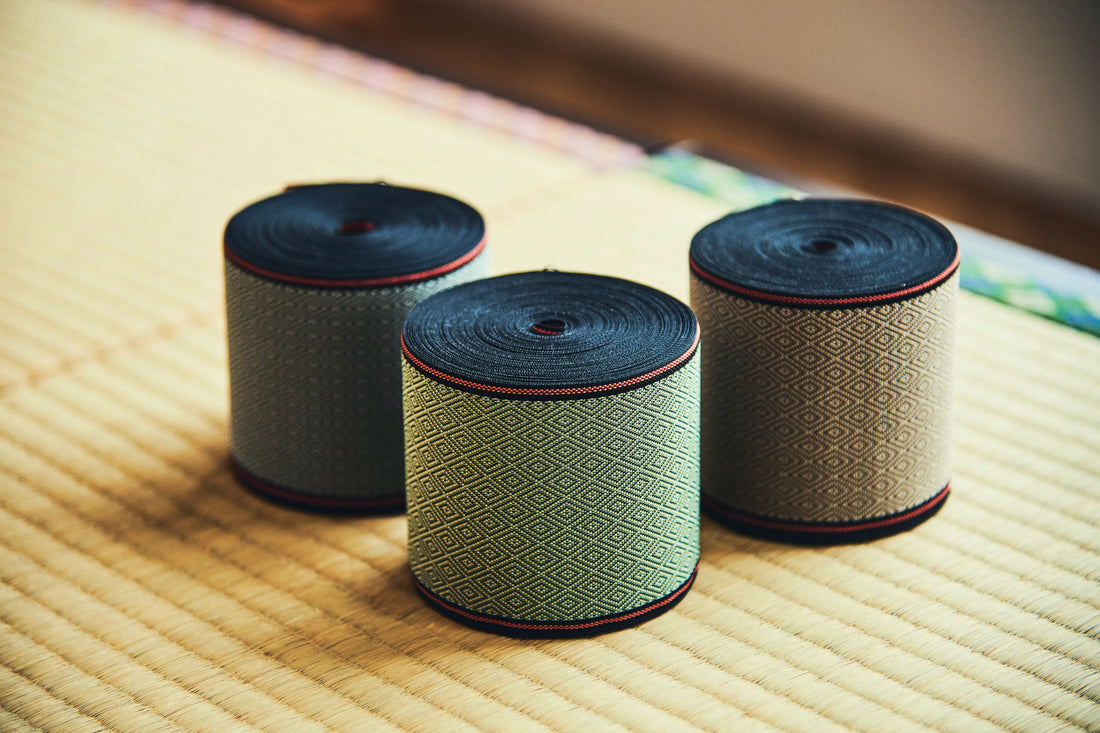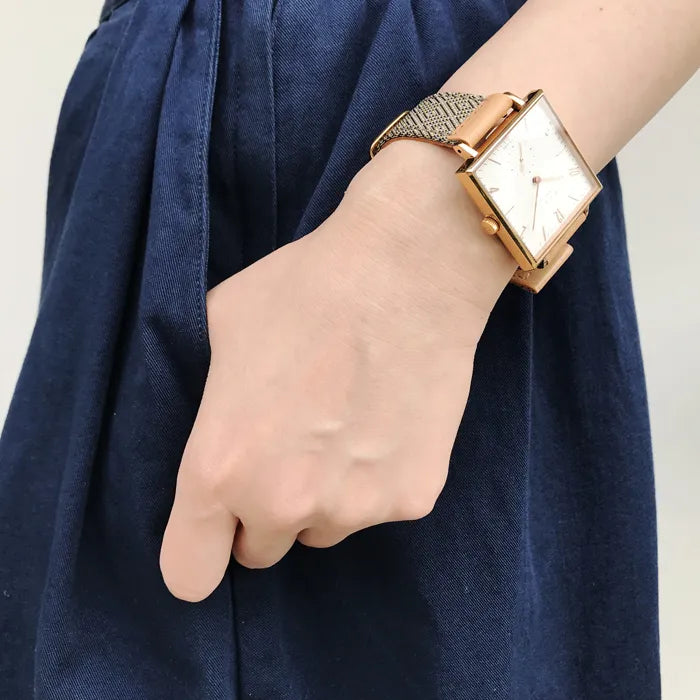

Tatami-beri is the material found along the edges of traditional Japanese tatami mats, enhancing their utility and decorative appeal. In ancient times, the tatami-beri that could be used was determined by a person’s social status, and it was forbidden to use tatami-beri higher than one’s own rank. However, in the modern day, people can freely choose the pattern of their liking, and the designs of products made by tatami-beri manufacturers have become more diverse. Now, tatami-beri are used not only for tatami mats, but also as decorative material for small accessories, also resonating with the tastes of young consumers. In this article, we will introduce you to the basics of tatami-beri, why you shouldn’t step on it, and a collaboration watch strap between long-established tatami-beri manufacturer Takata Orimono and the watch brand Knot.
Contents
- Tatami-beri explained
- Why you should avoid stepping on the edge of a tatami mat
- Tatami-beri straps by Takata Orimono
- Adding a touch of Japanese-style fashion to your wardrobe through tatami-beri
Tatami-beri explained
Tatami has a unique texture, aroma and function, and has a large following of enthusiasts. However, tatami-beri, attached to the edges of tatami mats, are not generally so well known. Let’s start by looking at the different types of tatami-beri.
Varieties of tatami-beri
There are four types of tatami-beri: Ungen-beri, Korai-beri, Murasaki-beri and Kii-beri. Traditionally, the more ornate the design, the higher the rank of the person who used it.
Ungen-beri
This type of tatami border was reserved only for the most prestigious individuals in ancient Japan, such as the Emperor, high-ranking imperial family members and emperors who had abdicated the throne. Subordinates, such as the imperial princes, high-ranking monks and Shogun military leaders, could also use the material if they were granted the appropriate status. In the picture scrolls of the Tale of Genji, the characters Nio no Miya (His Fragrant Highness) and Onna San no Miya (the Third Princess) are shown sitting on tatami mats with this type of border. The elegant pair of imperial dolls displayed for the Hina Matsuri (Girls’ Day) festival are also sat on these mats, symbolizing their prestige.
Korai-beri
This is a tatami-beri woven with patterns such as clouds and chrysanthemums on a white cloth. The Imperial Princes, regents and ministers used Korai-beri featuring large patterns, while the nobility used Korai-beri with smaller patterns. It is now quite rare to find small-patterned Korai-beri, but those with large patterns are still used to this day in the tatami rooms of shrines and temples, as well as in tea rooms.
Murasaki-beri and Kii-beri
Court nobles of the fourth and fifth ranks used purple Murasaki-beri, while those of the sixth rank and below used yellow Kii-beri. This refers respectively to the Tenjobito officials who were permitted to enter the palace, and the Jige bureaucrats and functionaries who were not. Those without a rank were not permitted to use tatami-beri.
Why you should avoid stepping on the edge of a tatami mat
Many Japanese people are brought up with the knowledge that they should not step on the tatami-beri. This applies not only to Japanese-style rooms in houses, but also in Japanese restaurants and tea rooms. Furthermore, walking without stepping on the edges of tatami mats also helps to prevent injury. Here, we will explain the reasons why it is considered bad manners to step on tatami-beri, which are a traditional element of Japanese way of life.
Respect for ancestors and parents
In the past, it was common to have family crests on the edges of tatami mats, and the act of stepping on a tatami-beri was considered to be as rude as stepping on the face of one’s ancestors or parents. Avoiding the edges of tatami mats was seen as a sign of good manners for samurai families, and it was also taught as a rule for the heirs of merchants. This custom persists in the present day, where stepping on tatami-beri is to be avoided.
Preventing falls
The area around the edge of the tatami mat may be uneven or wavy, and may be raised compared to the tatami mat itself. Although it may seem like a small difference, the tatami mat itself is slippery, so there is a possibility that elderly people with weaker legs or people walking around the Japanese-style room without looking down may trip over the edge of the tatami mat. For this reason, the phrase “don’t step on it” became common, meaning you should take care not to step on the tatami edge as you move around the room.
Preserving the order of space
The tatami-beri also has the meaning of a boundary that distinguishes between people of high status and ordinary people, and between the house owner and guests. Stepping on the tatami edge was thought to violate this boundary, and disturb the proper arrangement and etiquette of the space.
Preventing wear and tear
In the past, tatami-beri were not very durable, so they were treated with great care. Also, because dyed materials were used for the borders, stepping on them could cause the colors to fade or the tatami itself to become distorted. However, nowadays, the durability of tatami borders has improved, and they are now less likely to be damaged even after long-term use.
A sign of respect for living things
It was not uncommon for tatami-beri to feature patterns of animals, flowers and other living things. This meant that, even though they were just patterns, stepping on the plants and animals depicted was seen as the same as actually harming them, and stepping on tatami-beri came to be considered bad manners.
Tatami-beri straps by Takata Orimono
Knot offers straps made in collaboration with Takata Orimono, a tatami-beri manufacturer. Here, we will dive into the world of Takata Orimono and take a closer look at the straps made using tatami-beri.

What is Takata Orimono?
Takata Orimono is a long-established manufacturer of tatami-beri, founded in 1892 in Kurashiki, Okayama Prefecture, where tatami mat edges are widely produced. It boasts the largest share of the Japanese market, with a selection of over 1,000 different tatami-beri designs. While continuing to maintain its high manufacturing technology and commitment to weaving since the time of its founding, the company is also working to develop a number of related products, such as accessory cases, belts and coasters, broadening the possibilities of tatami-beri to new horizons.
Tatami-beri straps by Takata Orimono
Okayama Takata Orimono Tatami-beri Straight Shape Strap
This watch strap features a lattice pattern inspired by the “Namako Wall” motif found in the samurai residences of the Kurashiki Bikan Historical Quarter. The strap is made from high-quality Japanese leather from Tochigi Prefecture, and the ends of the strap are wrapped in leather to prevent the tatami-beri from fraying. The combination of the tatami edge and leather creates a design that blends tradition and modernity, appealing to any age and gender.
If wearing it with a Knot watch, we recommend a simple model such as the SQ-32 Square, which features a classic design, or the CS-36 Small Second, which is reminiscent of an antique timepiece.
The strap will certainly look the part when paired with a yukata, kimono or Japanese-patterned fashion, but it is also an ideal match for a simple plain white shirt or linen jacket to highlight the strap’s design and add a touch of style. You can use it for yourself, give it as a gift to friends and family, or even wear a matching pair with your partner.

Adding a touch of Japanese-style fashion to your wardrobe through tatami-beri
Tatami mat edges are used not only for protecting tatami mats and for decorative purposes, but also for a wide range of other products such as watch straps, wallets, and belts. By incorporating tatami-beri in your accessories, you can infuse your look with a touch of traditional Japanese craft, and create a disincentive look and feel.
If you would like to wear a fashion item that sets you apart from your friends, or like the idea of accentuating your outfits with a touch of Japanese traditional style, please visit the Knot global website any time, or a Maker’s Watch Knot gallery shop the next time you visit Japan.